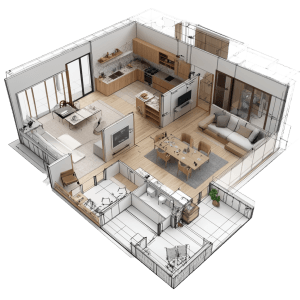
AI Powered Contstruction & Interior Experts.
AI-Driven Floor Plans
& Custom Designs

Partner with us for seamless,
innovative construction solutions.

What is AI-Driven Design?
An overview of how AI is revolutionizing the design process. Highlight how AI uses data and preferences to generate floor plans and interior designs that perfectly suit a client’s needs.
Why AI Matters?
AI processes vast amounts of data in seconds, allowing for real-time adjustments to floor plans and designs. Traditional design methods rely on manual revisions, which can take days or even weeks. With AI, designs are generated almost instantly based on user inputs, drastically reducing turnaround time.
AI eliminates human error by using algorithms that analyze every detail with precision. This ensures that measurements, structural elements, and design specifications are accurate to the smallest detail. Traditional methods often rely on manual calculations and adjustments, increasing the chance for mistakes, especially in complex projects.
AI customizes designs based on specific user preferences like layout, materials, and space usage. By using machine learning, AI learns from previous designs and client preferences, offering highly tailored solutions in minutes. Traditional methods can personalize designs but typically require multiple iterations, which takes time and effort.
AI can factor in environmental data, historical trends, and sustainability requirements automatically. It adjusts designs for efficiency in energy consumption, material usage, and cost-effectiveness, all in real time. Traditional methods rely on the expertise of architects and engineers, who may not be able to assess all variables as quickly or comprehensively.
With AI, clients can modify room sizes, layouts, or other preferences, and the system will immediately regenerate the design. This interactivity enables instant feedback and improvements, whereas traditional methods often require multiple drafts and rounds of revision.

Customizable and Efficient Floor Plans
AI customizes designs based on user preferences like room size, layout, and style. Highlight the efficiency and quick turnaround that AI provides compared to manual design processes.
AI systems allow users to input specific dimensions for rooms, adjusting the design in real-time. For instance, if a user specifies a bedroom of 12x14 feet, the AI will instantly adjust the overall floor plan to accommodate this requirement while maintaining a logical flow between spaces.
Whether a user prefers an open-plan living area or partitioned spaces, AI can analyze these preferences and generate layout options that match. By understanding spatial relationships, AI ensures that the layout is optimized for both functionality and aesthetics, balancing factors like foot traffic, natural light, and privacy.
AI adapts designs to reflect the user’s preferred style, whether it’s modern, traditional, or minimalistic. It can recommend materials, colors, and finishes based on these preferences, ensuring the design is aligned with the client’s vision. AI's deep learning capabilities also allow it to suggest alternatives based on trends or sustainability criteria.
Unlike manual design processes, which often require multiple drafts and extended discussions between architects and clients, AI provides almost instant feedback. Once the preferences are input, the AI processes them immediately, generating a customized design in minutes. This allows users to see different options, make quick modifications, and get immediate results without waiting days or weeks for revisions.
In addition to speed, AI is highly efficient because it can handle multiple variables at once—optimizing room size, layout, style, and even energy efficiency—simultaneously. This eliminates the need for back-and-forth communication and lengthy redrafting, drastically reducing the time needed to finalize a design.
By automating these complex tasks, AI ensures a faster, more precise, and highly personalized design process compared to traditional manual methods, where changes can be labor-intensive and time-consuming.

3D Visualizations and Real-Time Modifications
Experience immersive 3D visualizations with real-time design modifications, allowing instant updates for enhanced decision-making.
AI enables users to explore detailed 3D visualizations of their floor plans, allowing them to virtually walk through rooms, inspect layouts, and understand spatial relationships before construction begins. This immersive experience helps clients better visualize their designs compared to static blueprints or sketches.
With AI, users can instantly modify elements like room dimensions, furniture placement, or materials, and the system will automatically update the 3D visualization in real-time. This allows for quick experimentation and on-the-spot adjustments, enabling clients to see the immediate impact of their changes without the need for redrafting.
By providing a clear, realistic view of the design, AI-powered 3D visualizations help clients make more informed decisions about their space. Whether it's adjusting wall placements, tweaking lighting, or changing materials, the ability to modify the design in real-time leads to better outcomes and a higher level of satisfaction.
Clients and designers can collaborate efficiently using real-time 3D visualizations. The interactive nature of the platform allows for easy discussion, feedback, and iteration, improving the overall communication process and speeding up design finalization.
Real-time updates in 3D ensure that every modification is precisely reflected in the overall design. This prevents errors and discrepancies that could occur later during construction, improving the accuracy and quality of the final build.
AI-Driven Design Features
Discover key features that make AI-powered design faster, smarter, and more personalized, enhancing your construction experience.
Real-Time Updates
3D Visualizations
Custom Layouts
Instant Modifications
Smart Optimization
Precision Planning
Designs
per day
Ideas
per day
AI-driven design offers faster, personalized solutions with improved accuracy and real-time modifications. It optimizes space, reduces costs, promotes sustainability, and enhances client collaboration through immersive 3D visualizations and smarter planning.
Traditional Design vs.
AI-Driven Design
Explore the key differences between traditional design methods and AI-driven design. Learn how AI enhances speed, accuracy, and personalization while reducing costs, improving collaboration, and delivering smarter, sustainable solutions.

Traditional
- Time-consuming process
- Manual adjustments
- Prone to errors
- Weeks to finalize
- Higher risk of overruns
- Limited feedback
- 2D static drawings
- Requires extra effort
- Slow modifications
- Issues discovered late

AI-Driven Design
- Instant generation
- Automated customization
- Precise and accurate
- Immediate results
- Optimized, cost-saving
- Real-time interaction
- Immersive 3D models
- Built-in eco-friendly
- Instant updates
- Early issue detection
